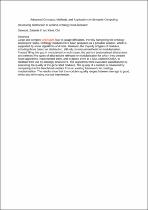JavaScript is disabled for your browser. Some features of this site may not work without it.
- ResearchSpace
- →
- Research Publications/Outputs
- →
- Book Chapters
- →
- View Item
| dc.contributor.author |
Dawood, Zubeida C

|
|
| dc.contributor.author |
Keet, CM

|
|
| dc.contributor.editor | Daramola, O | |
| dc.date.accessioned | 2021-03-07T18:26:16Z | |
| dc.date.available | 2021-03-07T18:26:16Z | |
| dc.date.issued | 2020-12 | |
| dc.identifier.citation | Dawood, Z.C. & Keet, C. 2020. Structuring abstraction to achieve ontology modularisation. In <i>Advanced Concepts, Methods, and Applications in Semantic Computing</i>. O. Daramola, Ed. S.l.: IGI Global. http://hdl.handle.net/10204/11835 . | en_ZA |
| dc.identifier.isbn | 9781799866978 | |
| dc.identifier.isbn | 9781799866992 | |
| dc.identifier.isbn | 9781799866985 | |
| dc.identifier.isbn | 1799866971 | |
| dc.identifier.uri | http://hdl.handle.net/10204/11835 | |
| dc.description.abstract | Large and complex ontologies lead to usage difficulties, thereby hampering the ontology developers’ tasks. Ontology modules have been proposed as a possible solution, which is supported by some algorithms and tools. However, the majority of types of modules, including those based on abstraction, still rely on manual methods for modularisation. Toward filling this gap in modularisation techniques, the authors systematised abstractions and selected five types of abstractions relevant for modularisation for which they created novel algorithms, implemented them, and wrapped them in a GUI, called NOMSA, to facilitate their use by ontology developers. The algorithms were evaluated quantitatively by assessing the quality of the generated modules. The quality of a module is measured by comparing it to the benchmark metrics from an existing framework for ontology modularisation. The results show that the module’s quality ranges between average to good, whilst also eliminating manual intervention. | en_US |
| dc.format | Abstract | en_US |
| dc.language.iso | en | en_US |
| dc.publisher | IGI Global | en_US |
| dc.relation.uri | DOI: 10.4018/978-1-7998-6697-8.ch004 | en_US |
| dc.relation.uri | https://www.igi-global.com/chapter/structuring-abstraction-to-achieve-ontology-modularisation/271121 | en_US |
| dc.source | Advanced Concepts, Methods, and Applications in Semantic Computing | en_US |
| dc.subject | Achieve ontology modularisation | en_US |
| dc.subject | Structuring abstraction | en_US |
| dc.subject | Ontologies | en_US |
| dc.title | Structuring abstraction to achieve ontology modularisation | en_US |
| dc.type | Book Chapter | en_US |
| dc.description.pages | 72-92 | en_US |
| dc.description.placeofpublication | Hershey, PA, USA | en_US |
| dc.description.note | opyright © 2021, IGI Global. Due to copyright restrictions, the attached PDF file contains the abstract of the full-text item. For access to the full-text item, please consult the publisher's website: https://www.igi-global.com/chapter/structuring-abstraction-to-achieve-ontology-modularisation/271121 | en_US |
| dc.description.cluster | Defence and Security | en_US |
| dc.description.impactarea | Information Security Centre | en_US |
| dc.identifier.apacitation | Dawood, Z. C., & Keet, C. (2020). Structuring abstraction to achieve ontology modularisation. In O. Daramola. (Ed.), <i>Advanced Concepts, Methods, and Applications in Semantic Computing</i> IGI Global. http://hdl.handle.net/10204/11835 | en_ZA |
| dc.identifier.chicagocitation | Dawood, Zubeida C, and CM Keet. "Structuring abstraction to achieve ontology modularisation" In <i>ADVANCED CONCEPTS, METHODS, AND APPLICATIONS IN SEMANTIC COMPUTING</i>, edited by O Daramola. n.p.: IGI Global. 2020. http://hdl.handle.net/10204/11835. | en_ZA |
| dc.identifier.vancouvercitation | Dawood ZC, Keet C. Structuring abstraction to achieve ontology modularisation. In Daramola O, editor.. Advanced Concepts, Methods, and Applications in Semantic Computing. [place unknown]: IGI Global; 2020. [cited yyyy month dd]. http://hdl.handle.net/10204/11835. | en_ZA |
| dc.identifier.ris | TY - Book Chapter AU - Dawood, Zubeida C AU - Keet, CM AB - Large and complex ontologies lead to usage difficulties, thereby hampering the ontology developers’ tasks. Ontology modules have been proposed as a possible solution, which is supported by some algorithms and tools. However, the majority of types of modules, including those based on abstraction, still rely on manual methods for modularisation. Toward filling this gap in modularisation techniques, the authors systematised abstractions and selected five types of abstractions relevant for modularisation for which they created novel algorithms, implemented them, and wrapped them in a GUI, called NOMSA, to facilitate their use by ontology developers. The algorithms were evaluated quantitatively by assessing the quality of the generated modules. The quality of a module is measured by comparing it to the benchmark metrics from an existing framework for ontology modularisation. The results show that the module’s quality ranges between average to good, whilst also eliminating manual intervention. DA - 2020-12 DB - ResearchSpace DP - CSIR ED - Daramola, O J1 - Advanced Concepts, Methods, and Applications in Semantic Computing KW - Achieve ontology modularisation KW - Structuring abstraction KW - Ontologies LK - https://researchspace.csir.co.za PY - 2020 SM - 9781799866978 SM - 9781799866992 SM - 9781799866985 SM - 1799866971 T1 - Structuring abstraction to achieve ontology modularisation TI - Structuring abstraction to achieve ontology modularisation UR - http://hdl.handle.net/10204/11835 ER - | en_ZA |
| dc.identifier.worklist | 24190 | en_US |






